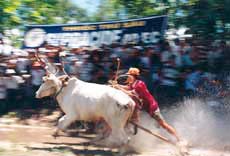Colorful costumes are being tailored and bulls are being trained and fed with fresh grass in the month prior to the Dolta Festival in the Mekong Delta.
 In the Bay Nui (seven mountains) region in An Giang Province and surrounds, the locals are all talking about the annual Vietnamese version of a chariot race.
In the Bay Nui (seven mountains) region in An Giang Province and surrounds, the locals are all talking about the annual Vietnamese version of a chariot race.
Traditionally celebrated by the Khmer people in An Giang, the Dolta Festival is now widely attended by all ethnic groups around the province and beyond, and draws a slew of domestic and foreign travelers from near and far. It’s all for a good cause - to celebrate the planting of the autumn-winter crops.
 As usual, the festive activities feature colorful parades, cultural shows, dancing and family dinners. But the most-awaited part of the festival is the bull races, which are open to contestants from An Giang and nearby provinces. This year’s races are already heating up the usually-quiet temple courtyard of Ta Miet in Tri Ton District.
As usual, the festive activities feature colorful parades, cultural shows, dancing and family dinners. But the most-awaited part of the festival is the bull races, which are open to contestants from An Giang and nearby provinces. This year’s races are already heating up the usually-quiet temple courtyard of Ta Miet in Tri Ton District.
Each racing tournament involves 38 pairs of bulls selected from competition in commune level. Most of the bulls have strong posture: big head, straight back, solid bone, long tail, small ear, round neck and gentle eye. The nearer the competition draws, the more boisterous the atmosphere becomes.
When the competition starts, each pair of bulls is yoked to a harrow which is made of a plank of wood 30cm wide and 90cm long with teeth underneath.
 Each round of competition includes two pairs of bulls. The controller stands on the harrow waving his whip. He must stand firm otherwise he will lose due to violation of regulations.
Each round of competition includes two pairs of bulls. The controller stands on the harrow waving his whip. He must stand firm otherwise he will lose due to violation of regulations.
The competition consists of two rounds: hu and tha. It can be considered that hu is the selection round, and tha the real contest, which displays the strength of the bulls and the skill of their controllers. In the hu round, each pair of bulls has to go around the competition ground two times for warming up and performance. If any pair steps on the harrow of another pair will lose. However, in the 120m-long tha round, those stepping on the harrow of others will win.  The departure and destination points are marked with two green and red poles 5m away from each other. The bulls in the lane of green poles must reach the destination marked by poles of the same colour. In the race the controllers hold a rattan whip or a round stick called xa lu. After the signal of the referee, the controller shoves the xa lu into the bulls buttock to make them rush forward amidst the resounding cry of the spectators.
The departure and destination points are marked with two green and red poles 5m away from each other. The bulls in the lane of green poles must reach the destination marked by poles of the same colour. In the race the controllers hold a rattan whip or a round stick called xa lu. After the signal of the referee, the controller shoves the xa lu into the bulls buttock to make them rush forward amidst the resounding cry of the spectators.
The final round is always the most boisterous time. The bulls seem like horses and their controllers, experienced jockeys. The racing bulls become the pride of the whole village. As such the controllers, the owners of the bulls and the bulls themselves all try hard to show their skill and strength. The prize-winning bulls are much loved for their efforts to bring about the honour for their owners.
 The bull racing in An Giang has an age old tradition. The men in the village take this community event as an opportunity to show their courage and dexterity.
The bull racing in An Giang has an age old tradition. The men in the village take this community event as an opportunity to show their courage and dexterity.
Owners of bull teams from Tri Ton, Tinh Bien, Chau Thanh, Chau Phu and Thoai Son districts of An Giang Province as well as Hon Dat and Kien Luong districts of Kien Giang have registered to compete at the 19th annual races. The organizers also expect registrations from bull drivers from Cambodia’s Takeo region.
This exciting and often hilarious event is a spectacle with a crowd of locals and visitors banging pots and pans with cooking utensils to drum up the mood from morning till afternoon.
More information on Dolta Ceremony and Bull Racing Festival
Time: From the 29th day of the eighth lunar month to the 1st day of the ninth lunar month (or to the 2nd day of the ninth lunar month in case of the eighth lunar month without the 30th day).
Place: In pagodas, or at each household of the Khmer people in Tri Ton or Tinh Bien District, An Giang Province.
Objects of worship: In remembrance of ancestral merits and wishing happiness and peace for the deceased’s souls.
Characteristics: Bull racing according to traditional ritual of the Khmer people.